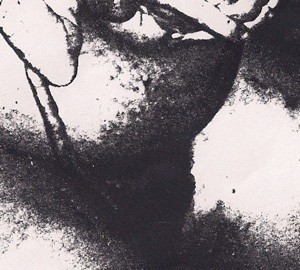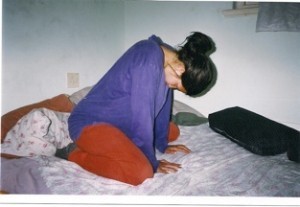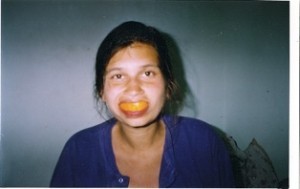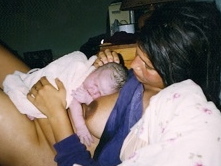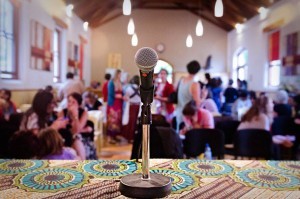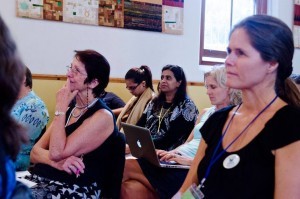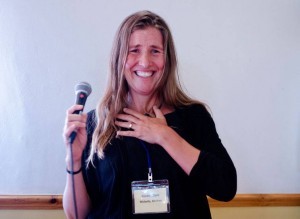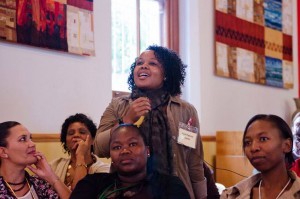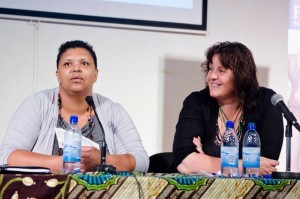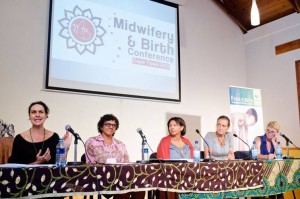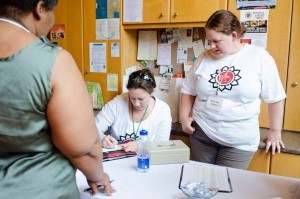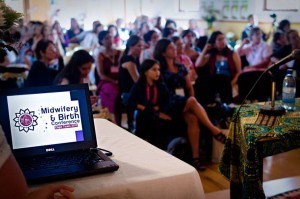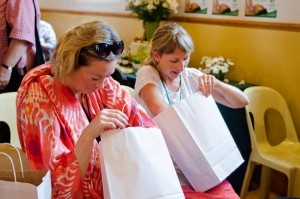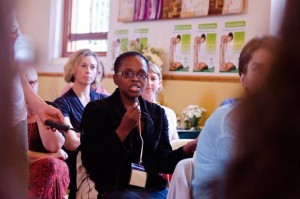Ruth Ehrhardt's Blog, page 8
October 18, 2015
Bungie Jumping Baby
It was her third baby and first home birth and she had created a beautiful warm cave for herself in her bedroom. Dim lights. Birth pool. Candles. Lovely burning oils. Hypnobirthing cd playing in the background. Safe and warm and cosy.
But labour had slowed down since she had gotten to fully dilated and we waited patiently for labour to pick up again. And it just didn’t.
And so the difficult decision was made to move to the nearby hospital to seek assistance.
I packed the car while Marianne stayed with the labouring mother and once we were ready to go, we made the slow shuffle across the much colder and starker open plan kitchen/dining area/sitting room to the front door. The slow shuffle of a labouring woman. A few slow steps forward and then stop to swing her hips as a contraction surges through her.
After a few steps, the baby’s head was suddenly on her perineum.
BOOM!
Plans changed…baby was going to be born on the kitchen floor.
I ran to get our equipment out of the car again and then knelt down behind the mother who was standing and rocking her hips.
Marianne and I sat, to the back and either side of the mother, averting our eyes so as not to make the mother feel observed, waiting for the head to emerge.
But then out of the corner of my eye I saw the entire baby shoot out of her mother in one big push. Reflexes I didn’t know I had dived to catch the baby, centimetres before she hit the floor.
Old classmates will attest to the fact that I was no good at catching balls at school.
But catching babies…well…I think this particular birth was certainly an initiation of sorts.
The post Bungie Jumping Baby appeared first on True Midwifery.
October 11, 2015
My Mother was the First one to Touch my Baby
Thursday 11 October 2001
I fell pregnant when I was 20 after returning from a hitchhiking session through Europe with my younger sister, Kate. I came back home to pack up and move to Ireland to study drama but when I realised the constant nausea was morning sickness, I made plans to move to a nearby farm community. I wanted my child to be born into the world in a natural setting.
I had grown up on a farm North West of Ceres and my mother while not trained to, had fallen into the role of being the farm labourers’ midwife.
When I was expecting my first baby, I saw no reason why my mother should not be the person to support and assist me.
I wrote the following two years later when I was expecting my second child.
*
I woke up with a desperate urge to shit at about one in the morning. I went to the toilet, came back to bed again and lay down again.
I tried to sleep.
Again, I wanted to poo, so again I went to the toilet, relieved myself and came back to bed. I tried to snuggle up to Nolan but my boep* was in the way, so I turned around and tried to sleep.
Again, I needed to poo, so off I went, but this time only dribbles of shit came out. My abdomen cramped.
I went back to bed.
The cramps kept on coming. Building up…building up…building up…ebbing away…ebbing away…ebbing away…
I sat up.
I put on the bedside light. I sat and felt the pains come and go…not sure. Scared to wake Nolan up. Eventually I did. He sat up immediately…
I phoned my mother. She was at a friend’s house. She told me to time the contractions. If they were less than a minute apart, she said, I would have to go into hospital because she wouldn’t able to get to me on time. My mother was going to go and fetch my sister Kate and then would be on her way.
I timed the contractions. 1 minute and 35 seconds apart. 1 minute and 20 seconds apart. 1 minute and 40 seconds apart. They felt fast and hard. I panicked. I didn’t want to go into hospital. I was set on a home birth.
The night before I had read (funnily enough) that to relax and slow down labour, a warm bath would help. Nolan ran a bath while I tried desperately to breathe through the rushes of pain. Breathing was impossible and painful, unbearable. Easier to grit my teeth, not breathe and bear it.
Once in the bath, great relief flooded my body. I relaxed in the pink hue of the candlelight. I could begin to breathe with the pain.
I phoned my best friend Nikki (who was studying in Jo´burg) from the bath. Nikki phoned me back from her dad’s cell phone. So good to speak to her, wished she was there, so far away.
Nolan had been instructed by my mother to line the bed with black bags. To get all our towels and sheets together. To put a pot of water, with a pair of scissors and a string in it, on to boil
I ate a paw-paw in the bath.
After an hour in the bath, I got out, wrapped in a white towelling bathrobe. The starkness of the light in the kitchen brought on the pain tenfold. It slammed into me.
At that moment, my mother arrived in a rented car. I hung on her.
Hello Mom.
Back in the candlelit room: it was quite magical and soft. Kate and my mother were there. My mother showed her how to breathe:
“Loosen your lips when you breathe out…”
“Prrrr…”
What a relief it was to breathe out. As though my pains, my worries, my tensions were leaving me. How it eased the burden. I felt the breath go until my lungs were empty. My mother’s gentle palm on my chest, gently pushing that last breath out.
Gone.
In limbo.
Then the first intake of breath. Gasp. Pain. Agony. Unbearable. As though my groin, my womb, were being ripped open. I felt like a shop-grilled chicken, a carcass, ripped open by some gluttonous fuck.
The pains came and they went. Everyone watched me. Kate sat in the corner, sketching the process. I breathed and squirmed and winced.
They built a pyre of cushions and blankets. I knelt before it and leaned into it. Softness enveloped me. A shock of pain grabbed hold of me. I couldn’t bear it. I couldn’t stand it anymore. Instead of breathing out, I buried my face in the cushions and screamed and screamed and screamed. I then flung myself on to my back.
The pain was gone…
Steve was playing the marimba outside. Ballie was drumming a gentle repetitive rhythm on his seisel drum. Again I felt bathed in bliss. I had a view of the sun rising from her bed and I thought,
Aaah, I’m going to have a sunrise baby.
Then the door opened. Pete walked in.
“How long have you been in labour for? How long’s this been going on for?” He demanded.
The spell was broken.
My mother’s cell phone rang. She answered it.
Chaos took over.
“When did your waters break?”
“They haven’t broken yet. Or I don’t know if they have…I had a bath earlier…”I stammered. I wanted to tell him to leave, to fuck off, that he was invading my sacred space. But no one asked him to leave, protected me, too scared of him, why?
“I told you not to have a bath, you know what happened to Noesj.”
(As though it was my fault).
“ I…” I didn’t know what to say.
He talked at my mother; she smiled weakly.
I screamed, wracked with pain, but also to scatter the energy.
My mother´s cell phone rang again. She answered, talking to some idiot. I screamed to stop her talking. To draw my mother´s attention back to me. Me! This is happening tome!
Put down your stupid fucking cell phone!
I walked around in that tiny space. Like a caged tiger. Pacing. Pacing. I was cold, shivering, even though the heater was on and it was hot that day. Everyone was watching me, sweating. I felt irritated, I wanted to escape. Anywhere, sleep, death, anywhere.
Vomiting. All kinds of shit coming out of me. Dribbling. Spraying.
I hung on Nolan. The shower rail. Pete. Squatting. Hanging. Screaming. Desperately trying to scream away the pain.
And then bliss, even sleep…
Then I was a lion. Wounded. Full of spears. On a cliff. Hunted. Roaring my last roar of pain.
Noesj came in. Fuck off, I wanted to say, we don’t need more people crowding in here, but I didn’t have the strength or courage. Instead, I beat Nolan’s back. He thought it was Noesj beating him on the back and told her to leave.
I can’t go on. I can’t. 12 hours. Contractions every 1 to 3 minutes. Fuck. Fuck. Fuck. I can’t go on. Just want to escape. Help me. Anything. Sleep. Death. Whatever.
Then,
“You’re fully dilated,” said my mother, “I can see the head.”
I reached down and felt my baby’s head and laughed with relief, wanting to cry, a new surge of strength rushing through me.
Breathe. Push (I thought my eyes were going to pop out) and out slid a perfect little head. Everyone rushed to see, leaving me gasping. Feeling this being hanging from me.
Another push and out he slid. Perfect little boy with all his fingers and toes.
We all cried.
I held my slimy perfect little baby.
My son.
We called him San.
San stayed attached to his umbilical cord for the rest of the day. We cut it that evening as the sun was setting. San’s placenta is planted under a peach tree on that farm.
We weighed San by bundling him in a baby blanket and hanging that from an old fish scale. He weighed 11 lbs ( I only worked out years later using an online converter that 11 lbs translates to 5kg!)
(and no…I didn’t tear)
The post My Mother was the First one to Touch my Baby appeared first on True Midwifery.
October 4, 2015
The Fetus Ejection Reflex
One cannot help an involuntary process, the point is not to disturb it…
If the labouring mother has had her basic needs met during the first stages of her labour, her body will prepare itself for something called the Fetus Ejection Reflex.
What are the basic needs of a woman in labour?
To feel safe
To leave the thinking brain (the neo-cortex) switched off
Silence
Darkness or low lights
Warmth
Not feeling observed
No adrenaline
It is very important that the labouring mother has utmost privacy during this time, otherwise the fetus ejection reflex will not take place.
How does it occur?
When a fetus ejection reflex is about to take place, the mother will suddenly become fearful and will say things like: “I want to die!” or “Kill me!”
It would be a mistake at this point to try to soothe or placate the mother with reassuring words.
Soon after this there will be some very strong contractions. The labouring mother will suddenly be full of energy and she will want to be upright.
The baby will be expelled in a few strong contractions. The Fetus Ejection Reflex is different from what we know as the second stage of labour, which is when the mother has to actively push the baby out.
When a true fetus ejection reflex takes place, the likelihood of the mother tearing is very low and the placenta should only take a few minutes to separate.
A fetus ejection reflex cannot take place if the basic needs of a woman in labour have not been met.
Read more on the Fetus Ejection Reflex here.
The post The Fetus Ejection Reflex appeared first on True Midwifery.
September 27, 2015
The Knitting Midwife
A midwife sits in a dark room.
She has a shawl wrapped around her shoulders.
A candle flickers on the table.
She is knitting.
From another room, you hear the soft moan of a woman. The midwife continues knitting. The woman in the other room becomes silent again.
The midwife continues knitting. After a few minutes, you hear the moan from the other room again and the midwife smiles to herself while she continues to knit.
Some time goes by and the midwife gets up and leaves the room. She goes to the kitchen. You hear her switch on the kettle.
The labouring woman continues to moan and groan – the pains seem to be intensifying.
The midwife comes back with a steaming cup of tea and a plate of biscuits. She dips her biscuits and sips her tea.
The labouring woman continues to moan softly in the next room.
The midwife is sitting on a rocking chair and now she rocks herself quietly while the woman in labour continues with her noises.
The midwife falls asleep.
The midwife sleeps for a while… the mother’s noises intensify.
The mother begins to shriek. She feels that the pain is too much. She is afraid that she is going to die.
The midwife opens her eyes and quietly listens. She slowly gets up (her bones creak a little) and she shuffles out of the room towards the sounds of the labouring woman.
Quietly, like a cat, the midwife slips into the room where the mother is.
The mother is grunting and screaming and the baby is born.
The baby is crying.
The midwife comes out of the room.
The mother is cooing to her baby.
The midwife shuffles back to her chair, sits down, smiles softly to herself and continues to knit.
The post The Knitting Midwife appeared first on True Midwifery.
September 20, 2015
Sai Girl
This is story of my daughter Sai Ngiah’s birth eleven years ago on Tuesday 21 September 2004…she is my second child and my first daughter and she decided to emerge face to pubis, nine days after her ‘due date’ on Spring Equinox.
I woke up at 12. Midnight. With pains. Ever increasing pains.
And so woke Derek up.
He sat up and rubbed his eyes.
“ Are you sure?” he asked.
“ Yes! It’s really sore this time!”
He had reason to ask. For the last three weeks I had been having pangs of pre-labour. I had phoned the midwife (Karen) and my mother countless times.
I decided to sit and wait a bit. Just to make sure. I didn’t really want to be caught crying wolf again…
This baby’s gotta come out at some stage…it’s nine days overdue.
The pains increased. I tried to lie down and rest but couldn’t. Instead, I wriggled around trying to breathe into the pain.
I finally decided to phone Karen at two. She came around.
“ These pains look more intense,” she smiled reassuringly.
Karen checked how dilated I was, “ Three cm dilated ,” she said, pulling off her rubber glove.
“ If I may, just give one piece of advice, don’t hold back with each contraction. Let go into it, you’ll find it goes much easier…” Karen smiled (her smile so reassuring), “you’re doing fine, I’ll come back later, phone me when you need me.”
I phoned my mother.
My mother asked, “are you sure?”
I rolled my eyes and reassured her that yes, this time I was definitely in labour.
Derek and I went downstairs (we didn’t want to wake San) and made a fire.
The pains were increasing. I began to moan softly to myself. I breathed deeply and moved with each one.
This labour felt so different from my first. I didn’t feel frightened. I didn’t feel scared. I didn’t feel bewildered. I didn’t feel freaked out by the pain.
I allowed myself to go with each pain. I allowed each pain to take over my body. I rode it. And within that I felt unbelievably strong and powerful.
The pains began to increase.
Derek phoned Karen.
My mother wasn’t there yet. Where was she?
I phoned her. Between contractions. Just to check where she was. She answered her phone. Mumbling. Still fast asleep.
“ Mom! It’s happening! Where the fuck are you?”
“I’m still in Prince Alfred Hamlet,” she mumbled, “ I thought it was another false alarm when you phoned earlier, so I went back to sleep.”
“Well, it’s happening and I need you to be here to look after San, so get moving!”
I switched the phone off.
I was livid.
My mother!
Karen arrived at about five. My mother soon after. My mother sat and watched me. Karen made tea. I squirmed and writhed on the floor. Derek held me. Breathed with me. Rubbed me. Spoke soothing reassuring words to me.
I squirmed and writhed in pain. On the floor. On the mat. In front of the blazing fire.
The pain increased.
I began to do push-ups. I felt strong, so powerful. I grunted and moaned.
My mother sat. On the red velvety piano stool. Her hands clutched between her thighs. Watching me.
I wonder what she thinks and feels watching her daughter go through this?
I sat. Kneeling with knees apart.
Breathing softly.
No pain.
Relaxing.
The pain starting again.
It began to build up.
Coursing through me.
As the pain reached its crescendo, I jerked forward and arched my back.
And roared.
The scream makes the pain more bearable.
San woke up. My mother got up. She heaved herself off the piano stool. She picked up her steaming cup of Rooibos and trundled up the creaking stairs to my first born.
I began to walk around. The pains were coming more often. I hung on Derek whenever a pain came. Screaming and hanging. Allowing myself to dive into the painfully. I found myself plunged into a darkness of unbelievable excruciating pain. And then suddenly, found myself on the other side. Out of it. And with it came a white-hot moment of clear beautiful bliss. And then I lost it. I fell. Back into the pain…as it slowly decreased and ebbed away.
I wanted, I craved a shower. But the washing machine was in the way. Derek moved it. Pushed it. Rolled it. Put his back into it. Moved it out the way. And turned on the shower tap. It was broken. The shower head was blocked. Nothing came out. Only trickles of water. Derek banged it. Nothing. It was broken.
Fuck.
Karen suggested a bath. I didn’t want to because the bath was upstairs. I was hesitant because I didn’t want to disturb San. I didn’t want to freak him out. But I felt the need for the comforting warmth of water. The relaxation. The relief of it.
I paced the downstairs floor, waiting for the next pain to come. And when I felt it building up, up, up, I flicked my hands wildly, motioning for Derek to come.
Hurry up!
And so I hung on him. Screaming and hanging. While Karen was upstairs, to run a bath.
I climbed the stairs (with some difficulty) and got into the small ugly brown bath.
Aaah, relief!
But brief. The bath too small. Cramped. No space really. Couldn’t move around when the pains came.
(San shouted from his room: “ inside voices inside, outside voices outside!”)
I nearly ripped the taps out of the wall. They ordered me out of the bath. Too risky…couldn’t have water spraying everywhere!
Back in my own room things got more intense. I was naked and hot and my lower back throbbed in absolute agony.
The pains came closer and closer together. Karen rubbed some oils into my lower back. I became bathed in sweet smells. My lower back melted.
Aaah. Relief.
I could hear my mother leaving the house with San. Closing the front door behind them.
An Egyptian goose sat across the road. On the chimney of the house of Natasha. I wanted to shout, “ Hey goose! Wrong house! Deliver the baby here!”
In between pains I sucked on slices of organic oranges for sustenance.
Chewing on as many as possible and then spitting them out before the next pain consumed me. Raced through me. Arching my back.
Screaming!
I heard myself. Screaming. Shouting.
“I can’t do this anymore! I can’t, I can’t!”
My back, almost numb with pain, felt swollen.
Karen offered me the TENS machine.
Uh oh, how much is this going to add to the bill?
Karen stuck the little sticky pads onto my back and clipped the monitor to my T-shirt. Karen pressed the little joystick button into my hand.
With each excruciating pain, my thumb pressed down on the buzzer. A slight electric tingling relieved the pain in my lower back somewhat. But more than anything, the little machine gave me a focus. Something to help me breathe through it all.
Karen checked me again. I wasn’t fully dilated yet.
I’m exasperated.
Karen suggested I lie down on my side (fucking hell!), the only way to dilate fully fast enough.
I did it. I would have done anything by that stage.
Oh, but fuck it is so sore!
There I was lying on my side. Derek next to me, facing me (his blue eyes pouring strength into my very being). Breathing with me as each pain came. Holding my eyes with his as I screamed. Pressing the button for the TENS machine with me. While blood and goo and slime dripped. Dribbled out of me.
The backup midwife arrived. She had dark brown hair and was slight and she smiled radiantly at me while she cooled my face with a damp face cloth.
Karen checked me again.
I am fully dilated!
Karen could feel the head. She told me to hold my breath and to push. I pushed, my cheeks puffing out, pushing with my hands against the wall. I could feel all my strength, all the pressure moving down there. To my nether regions. I could feel the little head tingling, stretching me. Slipping in and out, not quite coming out. Not wanting to come out. It stung. I pushed, wanting to get the baby out. Karen told me slow down. The baby was lying posteriorly. Facing the wrong way. Karen told me to take it easy or that I might tear. Karen helped me breathe into the next rush of pain while the backup midwife held my right leg up. I held the leg up against her chest. I pushed with all my strength against the woman (afraid I might push her out the window!).
In a grown of painful relief, the head emerged and the little body shot out in a gush of yellow water.
The baby lay there, not quite breathing and blue, an aquatic creature from another realm. Karen placed an oxygen mask over the baby’s face. The little body began to wriggle and move as life seeped into it. A little wail emitted from its little lungs.
Karen placed my slimy little daughter into my arms.
I sobbed hoarsely, clutching the little girl,
“Oh my God, she’s so beautiful, she’s perfect!”
I said it over and over again.
The post Sai Girl appeared first on True Midwifery.
September 13, 2015
In This Moment I can Only Love you.
In this moment I can only love you.
I can only be there for you. Open my heart. And just be.
Open. Empty.
You grip my hand, tightly, your nails digging into my flesh.
You are on your knees, on the floor. Your body bearing down. All concepts and ideas of how to birth are gone and all you can do is just be with your body. Allow your body to just take over.
I am here.
And yet I am not.
I try to disappear because the space you are taking up is huge.
Massive.
The universe groans as it makes space for you to birth this baby.
It does feel as though time suspends itself. It really does.
Nothing else can exist in this moment.
I have to become nothing. Empty. Open hearted. Here. and nowhere else. For you.
You are incredible. Amazing. Did you know that you were capable of this?
I am in awe.
In this moment. I can only love you
The post In This Moment I can Only Love you. appeared first on True Midwifery.
September 6, 2015
Anamboya means ‘midwife’ in Shona
I have heard about this Zimbabwean midwife in the informal settlement of Masiphumelele for about a year now. I have heard that she is a traditional midwife and that many women in the Zimbabwean community in Cape Town seek her out during their pregnancies for their births. I have also heard that she has expert fingers that can detect when a baby is lying breech and that those same nimble fingers can also turn the baby so that it can be born head first.
Grace, who is also from Zimbabwe, and who lives on Red Hill, first told me about this midwife and Grace was the one who arranged for me to meet the midwife. On Sunday morning, I drove up to Red Hill and fetched Grace. Grace would take me to see the midwife and also act as interpreter, since the midwife spoke very little English. Grace’s sister Alice, and Grace sister-in-law Privilege, with her 18 months old daughter, also called Grace, tagged along – they also wanted to consult the midwife.
It was a beautiful day and as we drove through the labyrinth of shacks and RDP houses in Masiphumelele, people walked about, many in their Sunday best, clutching Bibles.
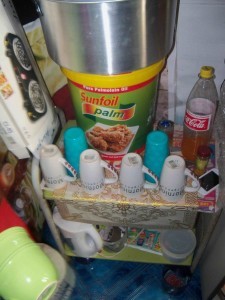
Inside the shack
The midwife, Clara, came and met us along the way, she got into my car and directed us the rest of the way – she did not want us to get lost. I was surprised at how young she was. I was told to park my car on a pavement and then we were guided down a sandy corridor between shacks to a small one roomed shack where another woman met us. This was Clara’s sister in law, Masiiwa, and it seems, that they are two midwives, who live and work together. The shack was small and simple, made of wood and sheets of metal. The walls were lined with cardboards and large pieces of paper. It was fitted with only a single bed, a television, and some some simple kitchen equipment. There was very little floor space and most things seemed to be stored under the bed or at the foot of the bed or hung behind the door or on the walls. Water was stored in empty oil buckets.We crowded into the tiny shack and I was given the best seat in the house – an upturned crate with a cushion on it.
The women who had come along all had readily agreed for me to sit in with their consultations and were happy for me to ask questions, write this blog and take some photos. It seems the midwives did not only work with pregnancy and birth but were known as general healers for women and children, so many came for their advice and wisdom. We were lucky that it was not so busy that day, sometimes there was a queue of people standing outside to see them.
Adult Grace had a check up first. She had skipped a period and wanted to know if anything was amiss. Clara asked her to lie down and Grace’s belly was massaged and palpated with cooking oil. This took some time but eventually Grace was told that all was well and she need not worry.
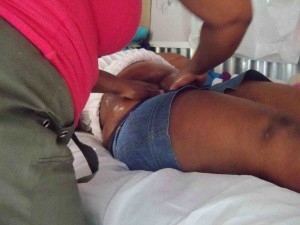
Grace having her belly palpated
Next was little Grace’s turn. She had been constipated and had developed a terrible fever and cough. She had not been eating properly for days and had lost weight. Her worried parents had rushed her to False Bay Hospital on Friday night, they live on Red Hill and have no transport themselves, and they had to pay someone to take them. They had been given some medicine and told to come back within 48 hours if things had not improved. Things had improved somewhat but little Grace was still weak and fevering and her mother wanted the midwives’ advice and guidance.
They prepared an enema for little Grace. A handful of salt, soap soap powder, and warm water heated on a little kerosene stove, were mixed in a bucket of water and then administered via enema while little Grace lay on her tummy on Masiiwa’s lap. Little Grace cried and since she was closest to me (her mother was watching from the door), I held her little hand and spoke soothingly to her. After administering the enema, Masiiwa held little Grace upside down and wriggled her about a little. Then she held the little girl in a squat over a towel and a hard little stool dropped out. Clara commented that the stool looked unhealthy and hard and that it was the stool releasing toxins into little Grace’s body that was making her ill. Some more enema was administered and more stool was passed. The little girls was then dunked in a cold bath and then given a full body massage with petroleum jelly. Afterwards, she seemed much calmer, her face was less sweaty and she had an appetite for porridge.
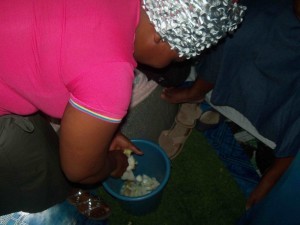
Clara cutting onion
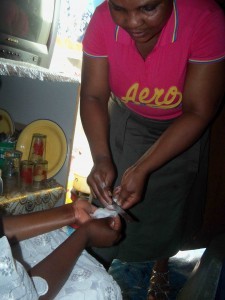
Clara scraping a mothball
Next it was Alice’s turn. Alice had had problems with her period. Sometimes her periods would last up to three months and left her feeling weak and with headaches. The midwives told her that it sounded like she had wind in her womb and that that needed to be extracted. Midwife Clara popped to the shop for Alice and came back with an onion which she chopped into the blue bucket (now clean). A fingerful of Vicks VapoRub was added and some hot water. Alice was instructed to take off her panties, sit on the bucket and to ‘steam’ her vagina. After about twenty minutes of this, Alice was asked to lie down again and Midwife Masiiwa massaged Alice’s belly with cooking oil to feel for the wind in her womb. She found it and massaged it. It bubbled. Clara started scraping a white ball into her hand, I asked what it was…it was a moth ball. The scrapings from the mothball, a white powder, was then mixed with Vicks VapoRub and oil and wrapped up in a ball of cotton wool and placed inside Alice’s vagina. She was told to keep it there until bedtime. Some more moth ball was scraped into Clara’s hand and mixed with petroleum jelly and Vicks VapoRub and rubbed into Alice’s anus.
They started cooking up something else and I asked what it was.
It was tea, they said, for our visitors!
While the tea brewed I fetched some gifts for them and the mothers they serve, biscuits for them and bags for mother and baby from The Pear Tree Project. They could have used one of those bags last week, they said, a lady arrived in labour at their shack and gave birth on their floor!
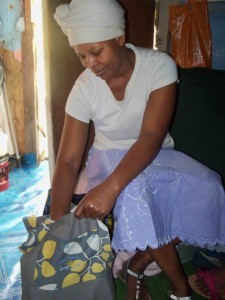
Masiiwe looking at the contents of the bags from The Pear Tree Project
While the tea cooked I was able to find out more about them.
They are originally from Buluwayo in Zimbabwe and have been in South Africa for about three years. They are sisters in law and they have left their husbands and children behind in Zimbabwe to come and earn money here. They both work as full-time live-in nannies during the week in the Southern Suburbs of Cape Town. On weekends, they come back to their shack in Masiphumelele and consult and go to church. They are self-taught, no one taught them. They see the work that they do as a spiritual calling and that God guides them as to what the right thing to do is in every situation.
They only serve women and children and all their clients are via word of mouth. They call themselves ‘Anambuya’ which means midwife in their language, Shona. I ask what the meaning of Anambuya is – they say it means ‘with woman.’
When a woman in pregnant they like her to come and visit them as much as possible although it is up to the mother to decide how often she comes. Women come from as far as Strand. At a check-up, they feel her belly and they see how the baby is growing and lying. If the baby is not sitting correctly, they ask the mother to come back another day to see if the position has changed. If it hasn’t they will try to change it.
If by seven months the baby has not chosen a good position they will perform a vaginal exam to see if there is enough space for the baby to fit. If there is not enough space, they will make space for the baby by making space in the pelvis using their fist (this is what I understood, it is difficult to know if I understood everything correctly). They will also check in labour to see if the baby is in a good position and will change that also if it is not optimal.
When a woman is in labour, they will be called and will usually be fetched and taken to where the birth is.
(I wish someone would fetch me and take me to births! I thought.)
I asked about bleeding after the birth – what do they do it the mother bleeds a lot after the birth. They looked at me blankly. They have never experienced that. And what about if a baby struggles to breathe? They rub it and shake it a little, blow in its ears, or give it a fright to wake it up.
When do they cut the cord, I ask. After the placenta is out, they said. Never cut the cord when the placenta is in, that is dangerous, they said.
And if the placenta won’t come? You put salt on your hand and you put your hand in the womb near the placenta. Then the placenta comes. And what is done with the placenta? Nothing – it is thrown away.
We chatted some more over tea and biscuits and sandwiches and samp and beans.
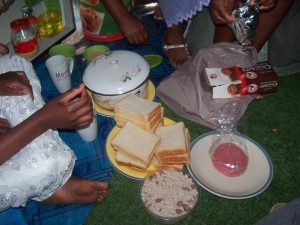
Our lunch with tea and biscuits
I asked what supplies they needed. This is the list they gave:
Vaseline (petroleum jelly), gloves, Vicks VapoRub, cotton wool, cooking oil. If anyone would like to contribute to these midwives please let me know via my Contact Form.
I thanked them for the work that they do, looking after so many mothers and babies. And for letting me sit and watch and listen.
And what do they charge for this service?
Nothing. It is free. Because it is a gift from God.
The post Anamboya means ‘midwife’ in Shona appeared first on True Midwifery.
August 31, 2015
What is Oxytocin?
Going into labour is like falling asleep…
Labour is a different state of being, a state of being with a lot of similarities to sleep. For a start, they are both states that cannot be forced. They just happen! Sometimes when we least expect it. We cannot decide or control the moment when we fall asleep. We can also not decide or control the moment when we “fall into labour.” But we can make it difficult for both to happen easily and most effectively.
Labour is like sleep because we need the same conditions to “fall into labour” as we need to “fall asleep.” We need to feel safe and warm and relaxed. We need to be in a place in which we feel comfortable, and we need to be free from pressure, anxiety or fear.
Oxytocin
When a woman is in labour she releases a hormone called oxytocin. Oxytocin is the hormone that makes the uterus contract during labour.
It is also the hormone of love.
Oxytocin is the hormone we release when we are enjoying a meal, or having a stimulating conversation. It is the hormone we release when we are making love and when we orgasm. It is the hormone that makes us feel in love, and it is the hormone that releases the milk when a mother is breastfeeding.
Isn’t it amazing that it is the love hormone that brings the baby into the world?
In hospitals synthetic oxytocin is often given to women. It has different names like Pitocin or Syntocinon. Synthetic oxytocin is given to make the mother’s uterus contract, which can help to birth the baby. But this synthetic oxytocin is not a love hormone. It is not like the oxytocin that is naturally secreted by the mother’s body. Synthetic oxytocin is just a hormone that contracts the uterus and helps to push the baby out. It is important that we know more about the effects and function of natural oxytocin, because when a labouring woman is under the effect of synthetic oxytocin she may have a decreased ability to produce natural oxytocin.
How is synthetic oxytocin used?
Synthetic oxytocin is used to induce a labour (this means starting a labour artificially) or to augment a labour (this means to speed up a labour that has stopped or slowed down). Synthetic oxytocin is also used for active management of the third stage of labour when the placenta is delivered (an injection of synthetic oxytocin is given to the mother to help deliver the placenta quickly). It is also used to stop a mother bleeding if she has a postpartum haemorrhage (when the mother’s uterus doesn’t contract after birth and she begins to bleed heavily).
Induction
These days it is very common for a woman to be induced to start her labour. She may be given many reasons for this: she may be over her due date, or her caregivers may be worried that her baby is getting too big, or that her baby is ill, or that she is ill.
Augmentation
When a woman is in labour, it is common for her labour to slow down or even to stop when she arrives in the hospital. There could be many reasons for this sudden slowing down of the labour: the lights are too bright, she is given a vaginal examination, a stranger enters the room, she is feeling watched or self-conscious, she is feeling rushed, cold or scared. Usually, if the labour doesn’t start up again after a certain amount of time, synthetic oxytocin will be used to get the labour going again. This labour is now very different to the natural labour of the love hormone. This new labour is now governed by a synthetic oxytocin, which has the effect of contracting the uterus without the behavioural effects of the natural love hormone.
The baby, when he or she is ready to be born,
will send a message that tells the mother’s body that it is ready.
The mother’s body can then begin labour by slowly releasing oxytocin, the hormone of love.
The mother and baby work together to bring the baby into the world.
The post What is Oxytocin? appeared first on True Midwifery.
August 24, 2015
Being on Call
Being on call…
I was asked some time ago:
If there was one thing you had known about becoming a midwife before you began training that you know now, would you still have chosen to become a midwife on call for home births?
My answer was: “The realities of being on call.Knowing that I would be on call 24/7. That my phone would have to be charged and near me at all times!”
I knew that attending home births and being on call would entail all of these when I chose to walk the path of midwifery and attending home births but the realities of it are quite different from any selfless fantasies one might have about it.
Seeing the disappointed faces of my children as we turn around the moment we walk into the library or leave the beach, or miss a much loved extra-mural activity. Having to miss birthdays. Leaving for a birth on Christmas day. Missing New Year’s. Missing my very good friend’s wedding.
Or feeling too tired to enjoy any of the above…
And having that bloody phone so close to my head as I sleep and having to jump up and check EVERY SINGLE MESSAGE that pings its way into my world at all hours of the day. I curse at pointless emojis and kisses and notifications that I have won R500 000 from Coca-Coal via sms – I am trying to sleep!
And having to check and answer every message and call even when you need to desperately sleep after two back to back births.
Being on call means being available. 100% available. It means being willing, and able, to drop everything, no matter how important and valuable, to go and sit and just be at someone’s birth.
If you want to practice a path of non-attachment then being an on-call midwife is it.
I have had a nice break from being on call, teaching in Spain and Portugal in July. Being able to leave my phone in my caravan while I taught, or letting it die completely for a day or two was a rare treat.
Now I am back in South Africa and life carries on. Being with my children. Four children. Homeschooling. Extra murals. Outings. Housework. Meetings. Teaching. Seeing clients. Walking on the beach.
Life!
And somehow I am supposed to drop everything and fit a birth into all of this? This busy, full, demanding life I have created for myself?
And yet, somehow, when that phone rings or pings, and it is time to go – whether in the library, or the beach, or at breakfast, or more than likely, in the middle of the night, while it is raining and I am in the deepest sleep – time is somehow able suspend itself and I am able to make space for this woman birthing her baby.
My mother was a midwife and her attending births was often more of a nuisance and an annoyance than fascinating to me while growing up. It meant that she would be tired and unavailable.
But, it also meant, that when I fell pregnant, she dropped everything to be with me in labour and for the first time I saw how essential the work she did was for the woman in labour – her calm and presence held me through that experience and afterwards I thought, “This is the coolest job on the planet!” and wanted to be able to do just that for women in labour after that.
But why do it? Why sacrifice family, children, friends? Is it worth it?
It is. It really is.
And I hope to be available in the same way for my own daughters one day.
The post Being on Call appeared first on True Midwifery.
August 17, 2015
The Cape Town Midwifery and Birth Confernce
Have you ever been to the Cape Town Midwifery and Birth Conference?
Well, if you haven’t and you are passionate about all things pregnancy and birth related, and live in, or near Cape Town (although people do travel from further afield to attend), you really really should come.
What is the CT Midwifery and Birth Conference and what makes it particularly special?
The conference began in 2013 when a bunch of women, got together and decided that they had had enough of the situation around birth in South Africa (the ridiculously high caesarean rates in the private sector and the abuse of labouring women in the public sector to name but a few). The CT Midwifery and Birth Conference was born and we were pleasantly surprised to find that many other people felt the same way and crowded little Erin Hall so that it was full to bursting!
One midwife who attended said that the conference felt like a home birth.
It is all about sharing and collaboration. It is about hearing the stories of all of those invested and affected in the services provided.
Mothers. Fathers. Families. Midwives. Doctors. Doulas. Birth Activists. Lactation Consultants. All those affected and invested – especially those on the receiving end.
The next conference (our third) will take place on the 30 – 31st of October 2015 at the Observatory Community Centre.
For more info and for the full programme and list of speakers, have a look here:
Cape Town Midwifery and Birth Conference official website
And here is the direct link if you want to book your ticket:
The post The Cape Town Midwifery and Birth Confernce appeared first on True Midwifery.

